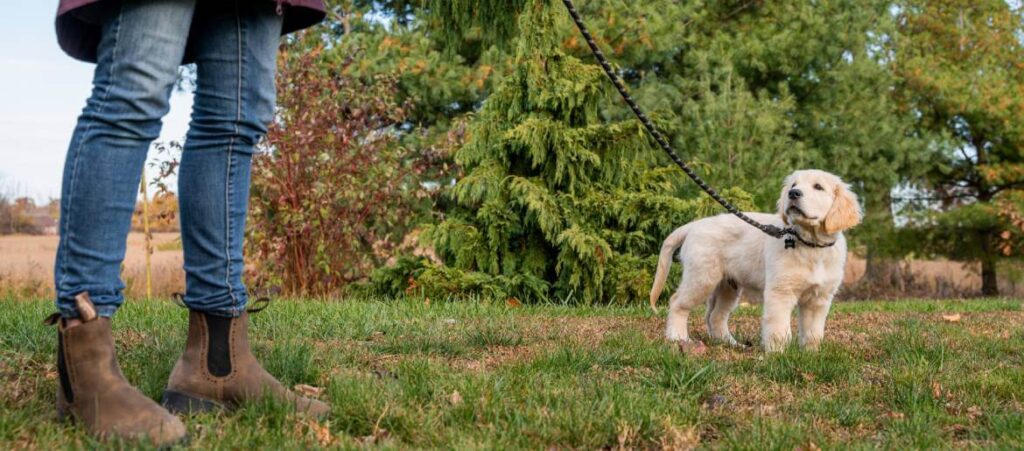Golden Retriever is a beautiful and wonderful companion. The intelligence of this breed helps the owner in many ways to reduce severe accidents. Training sessions enhance their intelligence even more and bring out the best of them. Recently people empathize in training the Golden Retrievers due to their ability to detect severe health changes. Like, the rise and fall in blood sugar and cancer. But, how to train your Golden Retriever for diabetic assistance?
You can seek the help of professional organizations that offers service dog-training programs to train your Golden Retriever for diabetic assistance. You can even opt for a trainer or train yourself following some guidelines if you want a cheaper option.
The nose of a Golden Retriever is about 40 times much more highly sensitive than a human. They can detect certain diseases just by smelling physical changes. Even the slightest change in hormone when they can detect the blood sugar rise and fall. They can signal their owner about the change if trained properly.
Before heading towards the training, procedure let us know a little about diabetes.
What Is Diabetes?
Diabetes is a chronic health condition that affects how the body turns food into energy.
The food that we eat breaks into sugar (glucose) and releases it into the bloodstream. When blood sugar rises, the pancreas gets the signal to release insulin. Thus, insulin acts like a key to let blood sugar in the bloodstream convert into energy for body cells.
But diabetic patients either can’t use the insulin or do not make enough insulin to convert glucose into energy.
Though diabetes does not have a specific cause, some risk factors are unhealthy food habits, lack of exercise, and heredity.
Diabetes is of 3 types;
- Type 1: insulin-dependent diabetes is an auto-immune reaction. It stops the body from making insulin.
- Type 2: insulin-independent diabetes cannot use the insulin well to keep the blood sugar normal.
- Gestational diabetes develops in pregnant women for a certain period.
The conditions of diabetes are;
- Hypoglycemia is a condition of lower blood sugar than normal related to diabetes treatment.
- Hyperglycemia is a condition of a high level of sugar or glucose in the blood. This is due to the lower production of insulin in the body.
Materials Needed To Train Your Golden Retriever For Diabetic Assistance
You need some materials to train your Golden Retriever more quickly and easily. Some of those requirements are:
- Samples of low blood sugar scent,
- Samples of higher blood sugar scent,
- Porous container/ Mesh colander,
- Treats,
- Other scents.
How To Train Your Golden Retriever For Diabetic Assistance?
Training a Golden Retriever is not an easy task. It requires lots of patience and considerations. Even though most owners prefer trainers or organizations, you can self-train your Golden Retriever for diabetic assistance.
Training Your Golden Retriever For Diabetic Assistance For Hypoglycemia
Hypoglycemia (low sugar level) unawareness is most common and dangerous for type 1 diabetic patients. Though some may experience seizures, shaking, confusion, and sweating when the blood sugar falls, some may not get any hint of a signal.
The highly heightened smelling sense of dogs detects the unique scent that a person gives off during a hypoglycemia episode quickly. Thus, with proper training, they may save many lives.
You must use positive reinforcement while training the dog. Reward the Golden Retrievers for correct behavior and ignored when they do not respond properly.
Method 1: The Associate With Reward Method To Train Your Golden Retriever For Diabetic Assistance
If you use rewards during the training, your Retriever will be more devoted to learning. You can teach them more easily. For this:
- Put the scent sample of hypoglycemia in a bowl with a mesh colander overtop. The colander protects the sample and allows the scent to pass through.
- Present the bowl to your Golden Retriever.
- If your Golden Retriever puts his nose in the colander and smells the scent, give him rewards and treats in the same colander. In this way, your dog will associate the scent as a reward.
- Then, move the bowl around to a different location to teach the Golden Retriever to locate the scent.
- As the Retriever gets older, provide the scent in smaller containers and hide the containers in various locations throughout the house. Reward the retriever when it locates the scent.
- Finally, teach your Golden how to signal alert when he detects the familiar scent. Teach the signal on command at the beginning and associate the signal with the location of the hypoglycemic scent. Then, remove the command. See whether the Retriever gets alert or not in response to the scent of the low blood sugar sample.
- Repeat this training until you reach perfection.
Method 2: The Shape Signal Method To Train Your Golden Retriever For Diabetic Assistance
Dogs cannot speak; the only way to communicate with them is through signals. Apart from communication, signals can help a lot in the training of a dog. The procedure of training your Retriever using signals are:
- Teach your Golden Retriever signals like a nudge of hand to alert you for hypoglycemia. Use the hand signal to command the behavior.
- Now provide a hypoglycemic scent in a small porous container using the hand signal. Give him rewards when the dog signals in response to the presence of the scent. Practice several times for weeks.
- Gradually remove the hand signal and continue to present the scent. Reward him if he signals. Then, hide the scent in a small container and let him find the object. If he does find the scented container and signals, reward him again.
- Finally, use different samples, some with normal scents, some with other scents, and some with the scent of low blood sugar. Keep those samples all over the house and watch. If he finds and signals the correct one, reward him; if not, then ignore.
Method 3: The Match To Sample Method To Train Your Golden Retriever For Diabetic Assistance
Dogs have a good sense of smell. They can distinctively distinguish different smells. You can use this as an advantage while training your pet. The steps of this method are:
- Teach the Golden Retriever to nudge as a signal of alert for low blood sugar.
- Provide two different specimens: one with the specific scent of hypoglycemia and the other without it. Place them in different corners of the house.
- Provide your Golden Retriever with a hypoglycemic scent on a separate object as well.
- Leave the Golden Retriever and ignore if he approaches the unscented sample. But if he approaches the scented one. Then, click and reward him.
- Now give commands such as nudge signal or other signals which you have chosen or taught your Retriever earlier. Reward him if he matches the scent and signals properly.
- Gradually stop giving commands. But, do reward him if he matches the scent and alerts.
Training Your Golden Retriever For Diabetic Assistance For Hyperglycemia
Hyperglycemia (high blood sugar level) shows the symptoms of increased thirst and hunger, fatigue, and headache and leads to cardiovascular damage or nerve damage if left untreated. Thus the Golden Retriever must give signals as soon as it detects the scent.
Unlike the scent of lower sugar levels, the scent of hyperglycemic is sweet and ketone-like. Your intelligent Golden Retriever can easily detect this stronger smell.
Similar to hypoglycemia, the training pattern remains the same for hyperglycemia also. However, the difference lies only in the signal you determine to detect higher blood sugar levels.
Signals Used While Training Golden Retriever For Diabetic Assistance
The common signals of Golden Retriever in the case of a change in blood sugar are;
- Bopping his nose
- Barking
- Nudging
- Spinning
- Growling
What is Diabetic Service Dog? What Do They Do?
The dog has a high sense of smell and hearing, which makes them an excellent hunter. This outstanding sense of smell of Golden Retriever has a huge advantage. With proper training, they can be working dogs like; rescue or service dogs. A diabetic service dog is a working dog that detects and alerts the caregiver as soon as it smells the change in blood sugar level.
Besides detecting sugar change, Golden Retriever also alert the caregiver in cases like;
- Detects the change and gives signals by; touching the owner’s nose or paw, putting the toy in their mouth, sitting in front of the caregiver, and staring or growling.
- Offers additional practical help by; bringing the medication or test machine or other needed things, barking, and asking other family members or even strangers for help.
What Should You Consider Before Getting A Train Golden Retriever For Diabetic Assistance?
A service dog doesn’t benefit all diabetic patients. Only those;
- With hypoglycemia unawareness
- Controls blood sugar using insulin pumps or injections
- Experiencing low blood sugar frequently.
- Children who require frequent blood sugar testing at night
Can get benefit from a service dog in an emergency.
Suppose you do not experience frequent hypoglycemic episodes and can control blood sugar through oral medication. It is better to avoid the responsibility and financial burden of the service dog.
What Are The Challenges Of Having A Train Golden Retriever For Diabetic Assistance?
Taking the responsibility of a dog is a commitment. The challenges involved are;
- You need to give the time necessary to build a loving bond with the service dog.
- You must feed, bathe, exercise, and maintain regular veterinary appointments.
- The ones who did not receive insurance coverage for a service dog are responsible for the dog’s significant management costs.
What Are The Benefits Of A Train Golden Retriever For Diabetic Assistance?
Though dog care and training involve many responsibilities and commitment, the Retriever rewards can be great.
A study published in the journal Diabetes Care by American Diabetes Association reported that the owner of diabetes alert dog has the following benefits;
- The decrease in worry about blood sugar level in 61.1% of respondents
- 75% had improvement in the quality of life
- 75% participated in physical activities with an enhanced ability
Though the training session for diabetic assistance is a little lengthy, it is easy. You just need to have patience and believe that can your Golden Retriever can achieve those skills by training.
However, if you don’t want to be involved in training yourself, you can either seek help from a trainer or an organization (with a long history of successful service training).
Being an intelligent breed, you can train Golden Retrievers easily and mold them in the way you want them to be.
Some FAQs
How much does it cost to train a diabetic alert dog?
The exact cost will depend on the organization and selected training program. But on average, a Diabetic Alert Dog can cost from $8,000 to $20,000. However, some non-profits grant dogs for free, and you only require to pay for training the dog.
What do diabetic alert dogs smell?
There are spikes of the chemical isoprene in the breath of diabetic patients, which increase with the increase in blood level. The dogs can smell this change of chemical makeup on a person’s breath as they exhale.
How can I get a free diabetic alert dog?
The first step in owning a Diabetic Alert Service Dog is to fill out our free online application, located on the top right-hand corner of our homepage. Within 48 hours of submitting your application, a representative will contact you.
Which dog breeds can alert you to the diabetic crisis?
Dog breeds trained to perform diabetic alert dog duties can include:
- Golden Retrievers.
- Labrador Retrievers.
- Mixed sporting dog breeds.
Is diabetes a disability?
Under most laws, diabetes is a disability. Both type 1 and type 2 diabetes are disabilities.
How much does it cost to keep a diabetic dog?
It is treatable, and your dog can live for years with a high quality of life. The cost of dog diabetes is highest in the initial treatment stage and can be a significant financial burden. Depending on the type of insulin and dose, your dog’s diabetes medicine may cost $40-$200 per month.
How does a dog act with diabetes?
Your veterinarian can discover your dog’s diabetes through routine bloodwork. Before that, you are likely to notice some diabetes symptoms: an increase in hunger and/or thirst, weight loss, and frequent or copious urination (some dogs start having accidents in the house).
Can you get a service dog for depression?
Service dogs can help people with depression, anxiety, and post-traumatic stress disorder (PTSD).
Is there a pill for diabetic dogs?
The U.S. Food and Drug Administration’s (FDA’s) Center for Veterinary Medicine has cleared Boehringer Ingelheim’s ProZinc (protamine zinc recombinant human insulin) as a safe and effective drug to reduce hyperglycemia (high blood sugar) and associated clinical signs in diabetic dogs.
What human food can I feed my diabetic dog?
“Fresh vegetables make excellent diabetic dog treats,” says Dr. Osborne. Some food dogs love includes broccoli, cauliflower, string beans, and cucumber slices. You can give fresh, cooked, or frozen veggies to your dog.
What is the best food for diabetic dogs?
Most vets recommend a high-fiber, low-fat diet. Fiber slows the entrance of glucose into the bloodstream and helps your dog feel full. Low-fat foods have fewer calories.





